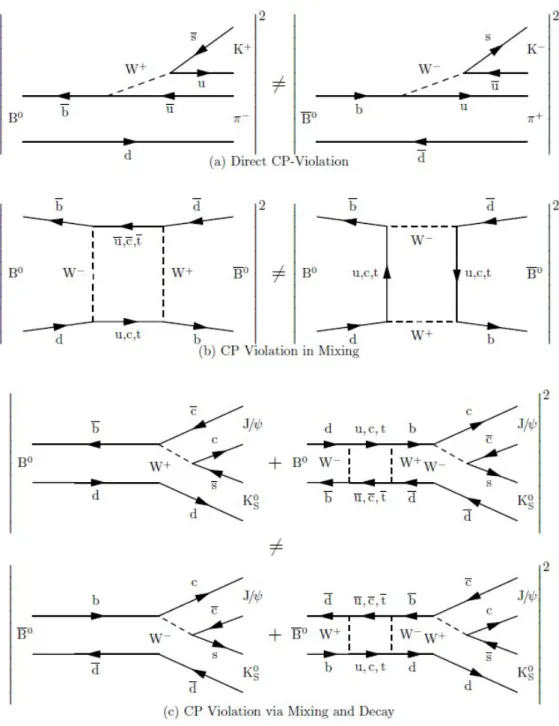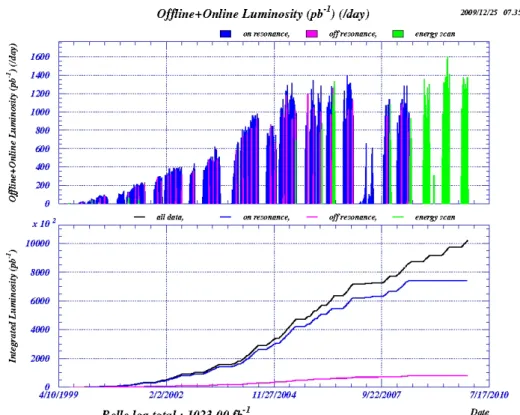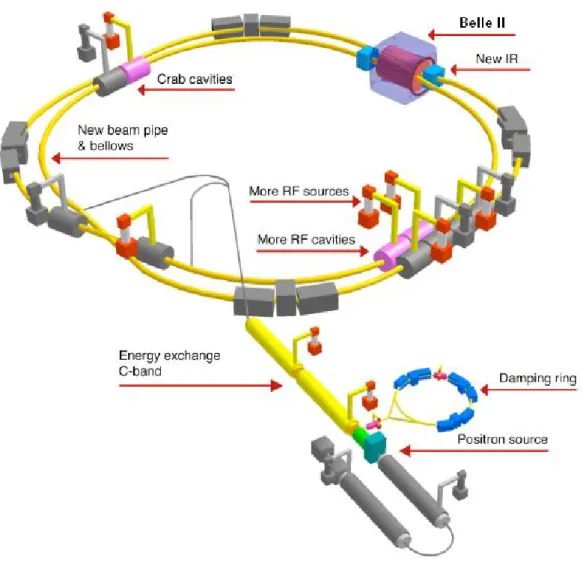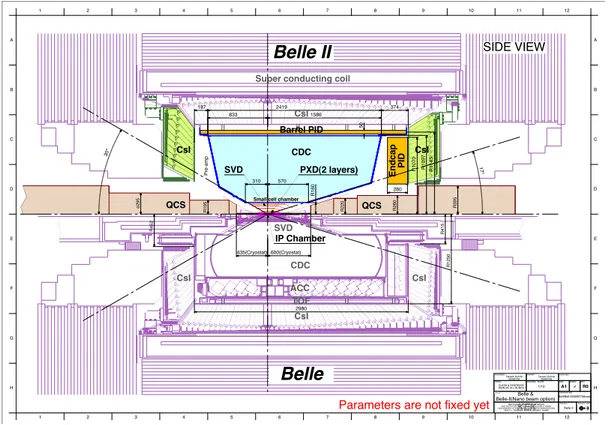Studies on Online Data Reduction for the Pixel Vertex Detector at the
future Belle II Experiment
Diploma Thesis of Claudio Heller Ludwig-Maximilians-Universit¨at
Department of Physics
Max-Planck-Institut f¨ur Physik Supervisor: Prof. Christian Kiesling
March 31, 2010
Abstract
In the big bang the universe was created with equal amounts of matter and antimatter. The bigger part of matter and antimatter annihilated into photons but somehow a small fraction of matter survived and evolved over billions of years into the universe of today which consists only of matter. Thus the small excess of matter over antimatter is a basic prerequisite for our existence. A fundamental ingredient in the explanation of this matter-antimatter asymmetry is CP violation.
The purpose of the Belle experiment at KEK in Japan is to observe and precisely measure CP violation in the decay of B mesons that are created in the circular KEKB collider. The KEKB collider accelerates and collides electrons and positrons at a center of mass energy of 10.58 GeV and holds with L= 2.11×1034cm−2s−1 the world record for instantaneous luminosity.
In 2013 the experiment will be upgraded to the Belle II experiment aiming to increase the luminosity by a factor of 40. To adapt to the higher luminosity the current Belle detector is modified and reconstructed to the Belle II detector.
To precisely measure the decay vertices of the B mesons the silicon based Pixel Vertex Detector (PXD) will come into operation as innermost part of the Belle II detector. It is mounted directly on the beampipe and consists of a total of 8 million pixels. The handling of the resulting extremely high data rate of16 GB/s constitutes a particular challenge for the data acquisition of the PXD. Before it can be stored, a reduction of the amount of PXD data by at least a factor of 10 is required.
In this thesis a method to reduce the amount of data created by the PXD is presented. The technique is based on a fast track finding algorithm that is applied to data taken by the next subdetector and it is capable to decrease the PXD data significantly without losing physical relevant information. The functional- ity of the data reduction method and first tests with simulated data are presented.
iii
Zusammenfassung
Das Universum entstand im Urknall mit Materie und Antimterie in gleichen Mengen. Der Großteil der Materie und Antimaterie l¨oschte sich gegenseitig aus und zerstrahlte zu Photonen, aber ein kleiner Bruchteil der Materie ¨uberlebte und entwickelte sich ¨uber Milliarden von Jahren zu dem heutigen Universum, das nur aus Materie besteht. Somit ist der kleine ¨Uberschuss von Materie gegen¨uber Antimaterie eine grundlegende Voraussetzung f¨ur unsere Existenz.
Ein fundamentaler Bestandteil der Erkl¨arung dieser Asymmetrie zwichen Materie und Antimaterie ist die CP Verletzung.
Das Ziel des Belle Experiments am KEK in Japan is die Beobachtung und pr¨azise Messung von CP Verletzung im Zerfall von B-Mesonen, die im ringf¨or- migen KEKB Beschleuniger erzeugt werden. Im KEKB Beschleuniger werden Elektronen und Positronen beschleunigt und bei einer Schwerpunktsenergie von 10.58 GeV zur Kollision gebracht. Mit einer instantanen Luminosit¨at von L = 2.11 × 1034cm−2s−1 h¨alt der Beschleuniger den aktuellen Luminosit¨ats- Weltrekord.
2013 wird das Experiment zum Belle II Experiment aufger¨ustet, mit dem Ziel die Luminosit¨at um den Faktor 40 zu erh¨ohen. Zur Anpassung an die h¨ohere Luminosit¨at wird der derzeitige Belle-Detektor modifiziert und zum Belle-II- Detektor umgebaut. Um die Zerfallspositionen der B-Mesonen p¨azise zu messen kommt der auf Silizium basierende Pixel-Vertex-Detektor (PXD) als innerster Bestandteil des Belle-II-Detektors zum Einsatz. Er ist direkt auf der Strahlr¨ohre befestigt und besteht aus insgesamt 8 Millionen Pixeln. Die dabei entstehende extrem hohe Datenrate von 16 GB/s ist eine besondere Herausforderung f¨ur die Messdatenerfassung des PXD. Die Datenmenge des PXD muss um mindestens einen Faktor 10 verringert werden, bevor sie gespeichert werden kann.
In dieser Arbeit wird eine Methode zur Reduktion der im PXD erzeugten Daten vorgestellt. Die Methode basiert auf einem Algorithmus zum schnellen Finden von Teilchenspuren. Dieser Algorithmus wird auf die, vom n¨achsten Unterdetektor gesammelten, Messdaten angewendet. Er ist in der Lage das Datenaufkommen des PXD maßgeblich zu reduzieren, ohne dabei physikalisch relevante Daten zu verlieren. Die Funktionsweise der Datenreduktion und erste Tests mit simulierten Daten werden pr¨asentiert.
v
Contents
1 Introduction
2 Physics Motivation
2.1 Fundamental Forces of Nature . . . . 6
2.1.1 Quantum Electrodynamics . . . . 7
2.1.2 Quantum Chromodynamics. . . . 7
2.1.3 The Weak Interaction. . . . 9
2.2 Standard Model of Particle Physics . . . 11
2.3 CP Violation . . . 12
2.3.1 Discovery of CP Violation in the Neutral Kaon System. . . 13
2.3.2 The CKM Model . . . 16
2.3.3 Time-dependent CP Violation. . . 19
2.4 Physics at a B-Factory. . . 22
3 The Belle II Experiment 3.1 Review of the Belle Experiment . . . 25
3.2 SuperKEKB Collider . . . 33
3.3 Belle II Detector . . . 35
3.3.1 Pixel Vertex Detector . . . 35
3.3.2 Super Silicon Vertex Detector. . . 41
3.3.3 Central Drift Chamber . . . 44
3.3.4 Particle Identification . . . 45
3.3.5 Electromagnetic Calorimeter . . . 45
3.3.6 KL0 and µ Detector . . . 46
3.4 Background . . . 46
4 Data Reduction 4.1 Why Data Reduction? . . . 49
4.2 The General Idea for Data Reduction . . . 49
4.3 Track in z-r-projection . . . 51
4.4 Hough Transform . . . 56
4.5 Parametrization . . . 57
4.6 Peak Finding. . . 60
4.7 Sectors in r-φ . . . 62
vii
5.2 The Data Reduction Processor . . . 69
6 Results 6.1 No Sectors . . . 78
6.2 Sector Configuration 1 . . . 79
6.3 Sector Configuration 2 . . . 81
6.4 Sector Configuration 3 . . . 83
6.5 Sector Configuration 4 . . . 84
6.6 Summary . . . 86
7 Conclusion and Outlook Figures. . . 90
1 Introduction
Since centuries scientists are searching for the answer to the question what matter is made of. Nowadays, it is known that the world around us consists of molecules composed of atoms. Each atom consists of a nuclear core, comprised of protons and neutrons, and electrons that are located around this core. The most simple atom is hydrogen which consists of one proton and one electron. These two particles have exactly opposite charge such that the hydrogen atom is neutral.
During the last century, the field of particle physics, which studies elementary particles and their interactions, found out that protons and neutrons are composed of even smaller particles called quarks. The electron in contrast is elementary which means it cannot be divided into smaller parts.
The Standard Model (SM) of particle physics describes the current knowledge of elementary particles and their interactions, except for the gravitational force. There are three generations of fermion pairs, the quarks (up, down, charm, strange, top, bottom) and lepton pairs (electron, muon, tau and the corresponding neutrinos). In addition, each particle has an antiparticle with the same mass but opposite charge. The standard model describes three different interactions: the weak, the electromagnetic and the strong interaction. The interactions are represented by force mediating particles, the gauge bosons.
The SM has been verified with high precision in particle accelerators and colliders, that have been constructed with huge technical effort. However, not every question was answered satisfactorily. For example, it has not yet been experimentally discovered why particles have different mass. The theory states that particles have mass due to the interaction with the Higgs field which is coupled to the existence of a Higgs particle. To observe this parti- cle is one of the aims of the Large Hadron Collider at CERN near Geneva, which will operate at a center of mass energy of√
s = 14 TeVby the year 2013 [1].
A drawback of the SM is the fact that it accounts for only 4−5 % of the known universe as it cannot explain dark matter and dark energy. Cosmology tells us that approximately23 % of the universe is dark matter and the mysterious dark
1
energy contributes the remaining 72 % [2].
Figure 1.1: A brief history of the universe
Cosmology also states that the universe has been created in the Big Bang around 13.7 billion years ago (see Figure 1.1). In the beginning the universe and its entire energy was concentrated in a single point from which it started to expand and cool down. A few moments (∼ 10−35s) after the singularity the universe was in a perfectly symmetric state where all interactions, except for gravitation, were of the same strength [3]. In the extremely hot and dense plasma quarks, leptons, gluons and photons were in equilibrium and therefore equally frequent. Because of the high energy density pairs of particle and antiparticle were created and matter and antimatter existed in equal amounts. Most of the particle-antiparticle pairs annihilated creating a sea of photons. Due to the fact that we exist, some particles must have survived. Although a matter to photon ratio of approximately 10−9has been observed no evidence of a significant amount of antimatter has been sighted [3]. The whole world, our solar system and the stars and galaxies in the observable universe consist of matter. The excess of matter over antimatter is
3 explained by an asymmetry in the reaction of matter and antimatter. This means that a marginal difference in the decay rate of matter and antimatter at high energies resulted in a slight excess of matter over antimatter. Then, after all the antimatter had been annihilated, some matter would have been left over to form today’s universe. To generate this cosmological matter asymmetry, Andrei Sakharov [4] formulated in 1967 a mechanism based on three conditions:
• Non-conservation of baryonic charge
• Deviation from the thermal equilibrium
• Breaking of the matter-antimatter symmetry (breaking of the C and CP symmetry)
The experimental particle physics community concerns itself particularly with the third condition, CP violation. CP violation was discovered in 1964 by Jim Cronin and Val Fitch in the decay of neutral kaons. CP violation means that the combined operation of charge conjugation (C) and parity (P) is not conserved.
C transforms a particle into its antiparticle of equal mass, momentum and spin, but opposite quantum numbers like electric charge. P is a mirror transformation.
A particle traveling to the right finds itself traveling to the left after a P transformation.
In 1972 CP violation was integrated into the SM by Makoto Kobayashi and Toshihide Maskawa. The formalism required the expansion of the quark model with three quarks to three generations with two quarks each, which was a brave step as by that time only the three lightest quarks - up, down and strange - were known. This resulted in a quark mixing matrix called Cabibbo-Kobayashi- Maskawa matrix (CKM matrix) including a complex phase, the KM phase. The matrix describes the strength of flavor changing weak decays, which means the transition probability of one quark to another.
After the discovery of the third generation of quarks (bottom, 1977) and leptons (tau, 1975) Bigi, Carter and Sanda proposed to search for CP violation in the neutral B meson system in 1980 [5] [6]. The observation of an unexpected long lifetime of the B mesons indicated a large time-dependent CP violation. Two experiments at B factories were constructed to investigate this CP asymmetry:
the BaBar experiment [7] at SLAC (Stanford Linear Accelerator Center) in the USA and the Belle experiment [8] at KEK (High Energy Accelerator Research Organization) in Japan. Both experiments use asymmetric electron positron colliders that provide high luminosities. The energy asymmetry of the collider causes a boost of the B mesons. Thus the small lifetime (τB ≈ 1.5 ps) of the B mesons can be directly translated to a distance measurement in boost direction.
It is not possible to measure the short lifetime of the B meson directly with
current technologies. By 2001 large CP violation in the B meson system was confirmed in the decay B0 −→J/ψKS0 [9] [10].
However, the amount of CP violation in the standard model is not enough to generate our matter dominated universe [11]. Therefore new sources of CP violation are needed to explain the matter-antimatter asymmetry. New physics, beyond the SM, could yield contributions to the observed CP violation and thus explain why we exist. These contributions could be observable in loop diagrams which makes CP violation an indicator for new physics in the range from 600 GeVto more than 500 TeV. Therefore the Belle experiment will be upgraded and replaced by the Belle II experiment in 2013 and the complementary LHCb experiment [12] has been set up at the LHC at Cern.
To measure the distance between decay vertex and production point of a B meson vertexing detectors based on silicon are used. Such a detector can determine the vertex position with a precision of 10µm and less. Two of these detectors will be used in the Belle II experiment. One is a silicon based strip detector, which is an upgrade of the Silicon Vertex Detector that has been used in the Belle experiment. It has four layers of modules arranged in windmill structure.
The innermost detector, the Pixel Vertex Detector (PXD), is a completely new development. It is installed directly on the beampipe and its silicon sensor modules are divided into small square pixels. Being very close to the interaction point the PXD is exposed to a lot of background particles which would make a strip based detector infeasible. The pixels have a width of 50µm and a length of 50 −80µm. In total the detector consists of eight million pixels and therefore creates a huge amount of data. In this thesis an algorithm is presented that helps to reduce the data to a volume that can be stored. It performs a simple two-dimensional tracking and determines which pixels will be saved and which can be neglected.
Chapter 2 gives a short introduction to particle physics. It starts with an overview of the theories combined in the Standard Model. Afterwards the principles of CP violation and its measurement are presented.
Chapter 3 is about the instrumental apparatus of the Belle II experiment. A short review of the Belle experiment is followed by descriptions of the SuperKEKB collider and the components that compose the Belle II detector.
The functionality of the data reduction is presented in chapter 4. The single steps of the procedure are discussed and their joining into a data reduction algorithm for the International Linear Collider (ILC) software framework is shown in chapter 5.
Finally the performance of the the data reduction method is discussed in chapter
5 6 showing first results.
This chapter starts with an overview of the Standard Model (SM) of particle physics. A brief description of the three fundamental forces of nature and the elementary particles included in the SM is given. This is followed by a review of neutral meson mixing, which led to the discovery of CP violation. The principles of CP violation and its manifestations in the B meson system are described.
2.1 Fundamental Forces of Nature
Only four fundamental forces or interactions are needed to describe the entire variety of our world from the attraction of the smallest elementary particles to the large scale issues of cosmology and astrophysics. An interaction is fundamental if it cannot be described in terms of other interactions. These four interactions can be seen in Table 2.1.
Gravitation is the weakest of the four fundamental interactions. If formulated as a quantum theory, its force mediating particle is the graviton. The graviton has been postulated but has not yet been experimentally observed. As it is solely attractive and its range is infinite, gravitation played an exclusive role in shaping the large-scale structures of the cosmos. It explains the relative movements of planets, stars and galaxies and is the interaction that we usually cope with in our daily lives. Gravitation was already investigated by Johannes Kepler and Isaac Newton and was revolutionized by Albert Einstein’s general theory of relativity in the beginning of the 20th century. General relativity could not yet be incorporated
Interaction Theory Force Carrier Relative Strength
Strong Quantum Chromodynamics gluon 1038
Electromagnetic Quantum Electrodynamics photon 1036
Weak Quantum Flavordynamics W±,Z0 1025
Gravitation Quantum Theory of Gravitation graviton 1 Table 2.1: The four fundamental forces of nature. A quantum theory of gravita-
tion has not yet been formulated and the graviton is still hypothetical.
6
2.1 Fundamental Forces of Nature 7 into the SM, as one has not yet succeeded in reconciling it with the concepts of quantum theory. Due to the relative small strength of gravitation, its effects are negligible in particle physics.
2.1.1 Quantum Electrodynamics
Classical electrodynamics describes the electromagnetic forces between charges and currents. It defines the electric field E and the magnetic field B and relates them to their sources, charge density and current density, in Maxwell’s equa- tions [13]. The quantization of energy was introduced by Max Planck when he studied the energy emitted by a black body. In 1905 Albert Einstein postulated that light energy is quantized to explain the photoelectric effect. Also the scattering of photons by electrons, which was investigated by Arthur Compton in 1923, applied the quantization of the electromagnetic field. It was Dirac who discovered in 1928 a first-order linear differential equation which describes the quantum mechanics of point-like, spin 12 particles, completely consistent with special relativity. Applying this equation to electrons, he predicted an electrically positive version of the electron, now known as the positron, which was discovered 3 years later in cosmic radiation. The combined theory, describing the interaction of the charged Dirac field with the quantized electromagnetic field, is called quantum electrodynamics (QED). This theory was enhanced by the works of Richard Feynman, Julian Schwinger and Sin-Itiro Tomonaga, who were awarded with the Nobel Prize in physics in 1965. In mathematical terms, QED is an abelian gauge theory with the symmetry group U(1), which can be derived by using local gauge invariance. The gauge field is the electromagnetic field and the mediating gauge boson with spin 1 is the massless, uncharged photon. The coupling constant describing the strength of the electromagnetic interaction is given by Sommerfeld’s fine-structure constant α ≈ 1371 . Thus QED describes all phenomena involving electrically charged particles interacting by photons. QED has been tested to a very high degree in quantum loops and serves as model for the other interactions.
2.1.2 Quantum Chromodynamics
In 1909 Ernest Rutherford performed a scattering experiment, where he fired alpha particles at a gold foil with a thickness of only a few atom layers [14].
From his observations he concluded the size of the atomic nucleus to be of the order 2−7×10−15m. This was the beginning of the development of the nuclear model as it is known today, which states that atomic nuclei consist of protons and neutrons. To explore and understand matter and its interactions on even
smaller scales, particle accelerators (e.g. SLAC, HERA, LEP, Tevatron) have been constructed during the last century. Especially experiments, analyzing the deep inelastic scattering of nucleons by electrons led to the current understanding of the structure of nucleons, which states that nucleons are bound systems of smaller particles called quarks. The force that holds them together is the strong force [15]. It is 100 times stronger than the electromagnetic force and thus is the strongest of the four fundamental interactions. The mediating particle of the strong force is the massless gluon.
Quantum chromodynamics (QCD) is the theory describing quark-gluon inter- actions. Quarks are fermions (spin 12) and there are in total six different quark flavors: up, down, charm, strange, top, bottom. For each quark there exists also an antiquark. In addition to electric charge, quarks carry a color charge, which is often just called color. There are three different colors: red, green and blue.
The antiquarks carry the corresponding anticolors (antired, antigreen, antiblue).
Quarks can only form color neutral particles which are called hadrons. There are two families of hadrons: baryons and mesons. Mesons consist of a quark and a antiquark in a color neutral combination. Baryons consist of three quarks. The most common example of baryons are the nucleons: proton and neutron (see Figure 2.1). Two up and one down quark form the proton whereas the neutron is composed of two down and one up quark.
Figure 2.1: Quark structure of proton and neutron
As there are three colors, the mathematical symmetry group is SU(3) and arises from local gauge invariance similarly to the electromagnetic interaction.
In contrast to the uncharged photon in QED, the gauge bosons in QCD, the gluons, have one color and one anticolor. The possible combinations of color and anticolor yields eight gluons. This gives rise to the speculation of the existence of glueballs. These hypothetical particles consist solely of gluons but have never been observed. The gluons have spin 1 like all force carriers with the exception
2.1 Fundamental Forces of Nature 9 of the Higgs boson (see section 2.1.3) and the hypothetical graviton (spin 2).
The fact that quarks and gluons do only exist in compounds (mesons, baryons) is called confinement. This phenomenon occurs since the strong force increases in strength with increasing distance of the particles. If a quark is torn away from such a compound, the binding energy increases and will at some point be high enough to create a quark-antiquark pair and thus split the compound into two individual hadrons.
2.1.3 The Weak Interaction
The weak interaction is different compared to the interactions discussed above.
There are two types of weak interaction, that are called charged and neutral currents. Charged currents are mediated byW+and W− bosons whereas neutral currents are mediated by Z0 bosons. These three massive gauge bosons were already postulated in 1968 by Sheldon Glashow, Steven Weinberg and Abdus Salam, who received the Nobel Price for their work on the unification of weak and electromagnetic interaction in 1979. W bosons have a mass of ∼ 80GeVc2
whereas the Z0 has even a mass of ∼ 91GeVc2 [16]. Therefore their discovery had to wait until there was a particle accelerator powerful enough to produce them.
In 1983 Carlo Rubbia and Simon van der Meer observed all three heavy gauge bosons [17] at the Super Proton Synchrotron at Cern and were awarded with the Nobel Price one year later.
The strength of the weak interaction is10−5 times smaller than the electromag- netic interaction which is the reason why it is called weak. From a mathematical point of view, the weak interaction is governed by the symmetry group SU(2).
The weak interaction is the only interaction that can change the flavor of particles and is therefore responsible for most particle decays. A historical example for the manifestation of the weak interaction is the radioactive β decay:
n →p+e−+ ¯νe
It describes the conversion of a neutron into a proton, an electron and a antineu- trino. On the quark level this means that a down quark goes into an up quark by radiating a virtual W−, which decays into an electron and the corresponding antineutrino (see Figure 2.2).
The weak interaction can even change the generation of quarks. This leads to the Cabibbo-Kobayashi-Maskawa model that will be explained in section 2.3.
Figure 2.2:β decay of a neutron
The weak interaction and QED can be unified into a single theory. This uni- fied theory was developed by Glashow, Salam and Weinberg resulting in the electroweak theory which is associated with the mathematical symmetry group SU(2)×U(1). It requires four massless spin 1 bosons: one tripletW1,W2,W3 and a singlet B0 as force carriers. Linear combinations of these yield the observable gauge bosons (γ, W+, W−,Z0):
W+ = 1
√2(W1−iW2)
W− = 1
√2(W1+iW2)
Z0 =W3cos(θW)−B0sin(θW) γ =W3cos(θW) +B0sin(θW)
The angle θW is called Weinberg angle and parametrizes the mixing of the bosons. This mixing is only valid for massless gauge bosons but experiment showed that W± and Z0 are heavy particles.
The solution to this problem is the Higgs mechanism which was developed by Peter Higgs in 1964 [18]. He introduced a new field, the Higgs field, and one accompanying massive spin 0 boson, the Higgs boson. The Higgs field has a non-zero vacuum expectation value and is responsible for the spontaneous breaking of the electroweak symmetry into the electromagnetic and the weak one. This so called Higgs mechanism gives mass to the gauge bosons W± and Z0. The photon remains massless. Higgs theory also explains the masses of all fermions (quarks and leptons) via coupling to the Higgs boson. However, the Higgs boson has not yet been experimentally observed but its discovery is one of the aims of the experiments at the LHC [19].
2.2 Standard Model of Particle Physics 11
2.2 Standard Model of Particle Physics
The standard model of particle physics joins together QED, QCD and weak in- teraction. It describes the currently known elementary particles and their inter- actions from which all matter is made of. An overview of the elementary fermions and the force mediating bosons of the standard model can be seen in Figure 2.3.
Figure 2.3: Fermions and bosons of the standard model of particle physics The elementary fermions have spin 12 and are grouped into three generations.
Each generation includes a pair of quarks, one with charge +23e and one with charge −13e, and a pair of leptons. All visible matter is composed of particles of the first generation: the two quarks up and down, the electron and the elec- tron neutrino. The heavier particles in the second (charm, strange, muon, muon neutrino) and the third generation (top, bottom, tau, tau neutrino) are unstable and thus decay into particles of the first generation. They can only be observed in high-energy environments. In addition there exists an antiparticle for each of these twelve elementary fermions. Particle and antiparticle have the same mass and spin but opposite charge.
The force mediating bosons have spin 1 and represent the three interactions of the standard model. The massless photon is the carrier of the electromagnetic force (see section 2.1.1) and the massless gluon mediates the strong force (see section 2.1.2).W± and Z0 are the heavy bosons of the weak interaction (see sec- tion 2.1.3).
All particles have different masses due to their coupling with the already men- tioned Higgs boson, which is the last ingredient for the standard model. In mathe-
matical terms the standard model is a gauge theory associated with the symmetry group SU(3)×SU(2)×U(1).
Except for the Higgs boson each of the standard model particles has been ob- served in experiments either directly or indirectly by its decay products. The top quark was the last quark to be discovered in 1995 at the Tevatron accelerator at Fermilab [20].
Despite the validation of the standard model over the last decades there are still questions left to be answered. Why are there exactly three generations of quarks and leptons? Why can the masses of the fermions only be measured and not de- rived by theory? How can gravitation be included in the SM? And of course the question what dark matter and dark energy are made of as they contribute 95
% of the energy density of the universe [2]. To give satisfying answers to these questions new theories like Supersymmetry (SUSY) and string theory have been developed but could not yet been validated [16].
Figure 2.4: All possible couplings of fermions and bosons in the standard model
2.3 CP Violation
CP violation means the breaking of the CP symmetry, which is the product of charge conjugation C and parity P.
2.3 CP Violation 13 Charge conjugation transforms a particle into its antiparticle:
C|qi=|¯qi. (2.1)
Applying charge conjugation to a particle changes quantum numbers like flavor and electric charge. Mass, momentum and spin of the particle remain unchanged.
The laws of QED and QCD are invariant under this transformation whereas weak interaction violates C symmetry.
Parity transformations mirror the physical system. Applying the parity transfor- mation to a coordinate~r or a momentum ~presults in a sign change, whereas the sign of the angular momentum~l=~r×~premains unchanged:
~r−→ −~P r ~p−→ −~P p ~l−→P ~l (2.2) Two sorts of vectors can be distinguished: polar vectors like~r and ~pthat change their sign, and axial vectors like ~l where no sign change occurs. Parity is not conserved in weak interaction, which was shown in 1956 by Chien-Shiung Wu in the beta decay of polarized60Co [21]. The result was that the mediating bosons of the weak interaction only couple to left-handed particles.
It was long believed that CP is invariant in the weak interaction.
Time reversal T is a third operation besides C and P. It transforms t into -t and thus corresponds to a reversal of motion:
~r−→T ~r ~p−→ −~T p ~l−→ −~lT (2.3) As Wolfgang Pauli already stated in 1955 [22], physics is invariant to the com- bined application of the three transformations C, P and T. This CPT-theorem is a substantial feature of quantum field theory.
2.3.1 Discovery of CP Violation in the Neutral Kaon System
In 1964 evidence for CP violation was found by James Cronin and Val Fitch in the neutral kaon system [23]. There are two neutral kaons, theK0 and its antiparticle theK¯0. These two particles decay into the same final states and therefore it is also possible that a K0 oscillates into a K¯0 and vice versa. The two major Feynman diagrams contributing to this oscillation are shown in Figure 2.5.
Figure 2.5: Box diagrams contributing to kaon mixing
K0 and K¯0 are the flavor eigenstates of the system. Observation of the decay of neutral kaons showed that K0 and K¯0 both can decay with a short lifetime (∼ 0.90×10−10s) into two pions and with a long lifetime (∼ 5.1×10−8s) into three pions. The longer lifetime can be explained by a phase space suppression of the decay. The K0 with a mass of 500MeVc2 is only a little bit heavier than three pions with a total mass of 420MeVc2 .
The state of the oscillating kaon system can be described by a wave function:
|ψ(t)i=ψ1(t)|K0i+ψ2(t)|K¯0i. (2.4) This wave function evolves in time according to the Schr¨odinger equation. The HamiltonianHis composed of the mass and decay width matrices MandΓ [24].
id dt
ψ1 ψ2
=
M− i 2Γ
ψ1 ψ2
(2.5)
Here H12 =H21∗ and due to CPT invariance the diagonal elements of the Hamil- tonian are the same:H11=H22. Derivation of the eigenvalues leads to the eigen- states
|K1i ≡p|K0i+q|K¯0i (2.6)
|K2i ≡p|K0i −q|K¯0i (2.7) with
q p =
v u u t
M12∗ − 2iΓ∗12 M12− 2iΓ12 and normalization √
p2+q2 = 1. If CP symmetry is conserved p and q are equal and thus the mass eigenstates in the kaon system are
2.3 CP Violation 15
|K1i ≡ 1
√2(|K0i+|K¯0i) (2.8)
|K2i ≡ 1
√2(|K0i − |K¯0i) (2.9)
withCP|K1/2i=±|K1/2i. If CP symmetry was conserved in the weak decay, the CP eigenstates would be equivalent to these mass eigenstates. Applying the CP operator on the pion final states yields:
CP|2πi= +|2πi CP|3πi=−|3πi
ThereforeK1corresponds to the short-lived kaon decaying into two pions and was named KS0, whereas K2 refers to the long-lived kaon decaying into three pions which was namedKL0. The time evolution of the mass eigenstates gives
|K1(t)i=e−(im1+Γ12 )t 1
√2(|K0i+|K¯0i) (2.10)
|K2(t)i=e−(im2+Γ22 )t 1
√2(|K0i − |K¯0i) (2.11)
where m1/2 is the mass of the particle K1/2 and Γ1/2 its decay width. Using Equation 2.8 and Equation 2.9 the time oscillation of the flavor eigenstates is obtained:
|K0(t)i=f+(t)|K0i+f−(t)|K¯0i (2.12)
|K¯0(t)i=f−(t)|K0i+f+(t)|K¯0i (2.13) with
f±(t) = 1 2
e−(im1+Γ12 )t±e−(im2+Γ22 )t
(2.14) These oscillations can also be derived for the heavier D and B mesons [24] [25]. As there are no phase space restrictions for their decays, the difference in lifetime of their mass eigenstates is negligible. The oscillation of neutral kaons and B mesons can be seen in Figure 2.6.
In 1964 Cronin and Fitch constructed an experiment to measure a better upper limit for the CP violating decayKL0 →ππ[25].K0 and K¯0 were produced 57 feet in front of the spectrometer. Over the distance the KS0 component has virtually
Figure 2.6: Oscillation of neutral Kaons (right) and B mesons(left). The bottom row shows oscillation with the measured ∆m. This value was multi- plied by five in the top row to make the oscillation visible
completely faded away and a pureKL0 beam remains. The surprising result of the experiment [23] was a branching ratio of
Γ(KL0 →ππ)
Γ(KS0 →ππ) =h(2.0±0.4)×10−3i2.
This observation established CP violation as a fact. The quantum mechanicalKL0 contains a small mixture of a CP even component in addition to its dominant CP odd part. KS0 contains in turn a small CP odd component in addition to its dominant CP even component.
|KL0i= 1
q1 +||(|K2i+|K1i) |KS0i= 1
q1 +||(|K1i −|K2i) (2.15) These are the mass eigenstates with the complex mixing parameter .
2.3.2 The CKM Model
In 1963 Nicola Cabibbo introduced a 2×2 mixing matrix to explain the long lifetime of kaons [26]. The matrix was based on only one parameter, the Cabibbo
2.3 CP Violation 17
angleθC = 13.04◦:
|d0i
|s0i
=
Vud Vus Vcd Vcs
|di
|si
=
cosθC sinθC
−sinθC cosθC
|di
|si
. (2.16)
|d0iand |s0i are the flavor eigenstates of the weak interaction and|Vij|2 describes the probability that a quark of flavor i decays into a quark of flavor j.
To explain CP violation this formalism has been extended by Makoto Kobayashi and Toshihide Maskawa to three quark generations [27]. Presenting their work in 1972 they predicted the bottom and top quark even before the discovery of the charm quark in 1974. The general3×3quark mixing matrix is named Cabibbo- Kobayashi-Maskawa (CKM) matrix:
|d0i
|s0i
|b0i
=
Vud Vus Vub Vcd Vcs Vcb Vtd Vts Vtb
| {z }
VCKM
|di
|si
|bi
. (2.17)
The CKM matrix is required to be unitary to conserve probability. The stan- dard parametrization of the CKM matrix uses three Euler anglesθ12,θ23 and θ31 describing the quark mixing and one complex phaseδ13representing CP violation:
VCKM =
c12c13 s12c13 s13e−iδ13
−s12c23−c12s23s13eiδ13 c12c23−s12s23s13eiδ13 s23c13 s12s23−c12c23s13eiδ13 −c12s23−s12c23s13eiδ13 c23c13
. (2.18)
Cosines and sines of the mixing angles are denoted bycij andsij.θ12is equivalent to the Cabibbo angle θC = 13.04◦.
Lincoln Wolfenstein introduced a different parametrization that emphasizes the structure of CP violation [28]. It uses four parameters λ, A, ρ and η that are related to the standard parametrization [24]:
s12=λ (2.19)
s23=Aλ2 (2.20)
s13e−iδ13 =Aλ3(ρ−iη) (2.21)
The Wolfenstein parametrization is unitary to all orders of λ.
VCKM =
1−λ2/2 λ Aλ3(ρ−iη)
−λ 1−λ2/2 Aλ2 Aλ3(1−ρ−iη) −Aλ2 1
+O(λ4) (2.22)
The values for the Wolfenstein parameters are λ = sinθc = 0.2257+0.0009−0.0010, A= 0.814+0.814−0.022,ρ= 0.135+0.031−0.016 and η = 0.349+0.015−0.017 [16].
The unitarity of the CKM matrix implies various relations between its elements [24]:
3
X
i=1
VjiVki∗ = 0 j, k= 1, . . . , 3, j 6=k. (2.23) These relations can be represented geometrically via triangles in a complex plane. All six triangles have different shapes but possess the same area which accounts for the amount of CP violation in the SM.
Most of these triangles have a very acute angle. However the triangle correspond- ing to the relation
VudVub∗ +VcdVcb∗ +VtdVtb∗ = 0 (2.24) has three sides that are of O(λ3)and large angles [25]. This relation corresponds to the decay of B mesons as it contains the complex conjugates of Vcb, Vub and Vtb. The shape of the triangle suggests large CP violation in B meson decay and gave rise to the proposal of so called B-factories [6] [5].
Division of its sides byVcdVcb∗ rescales and normalizes this unitarity triangle. The complex coordinates of the vertices of the triangle are (0,0), (1,0) and (ρ,¯ η) with¯
¯
ρ≡ 1− λ2 2
!
ρ and η¯≡ 1− λ2 2
!
η (2.25)
The inner angles of the triangle are defined by
φ1 ≡arg −VcdVcb∗ VtdVtb∗
!
φ2 ≡arg −VtdVtb∗ VudVub∗
!
φ3 ≡arg −VudVub∗ VcdVcb∗
!
. (2.26)
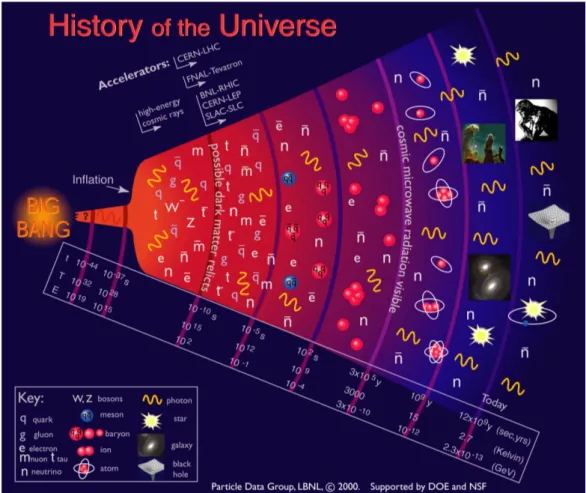
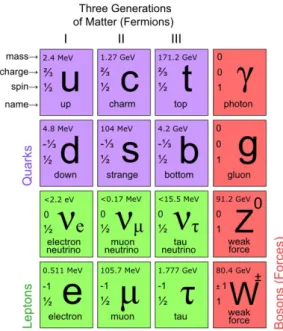
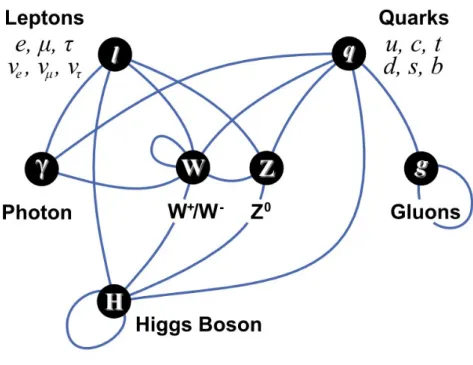
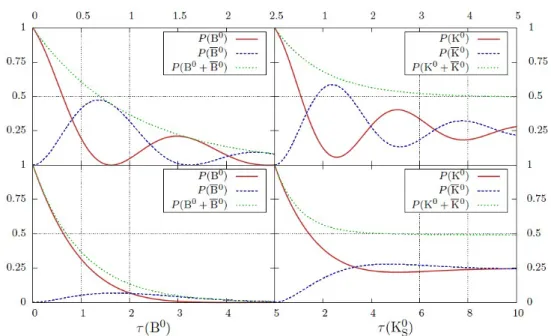
![Figure 2.8: Current constraints on the CKM triangle [29]](https://thumb-eu.123doks.com/thumbv2/1library_info/4015544.1541382/28.892.166.750.180.481/figure-current-constraints-ckm-triangle.webp)
